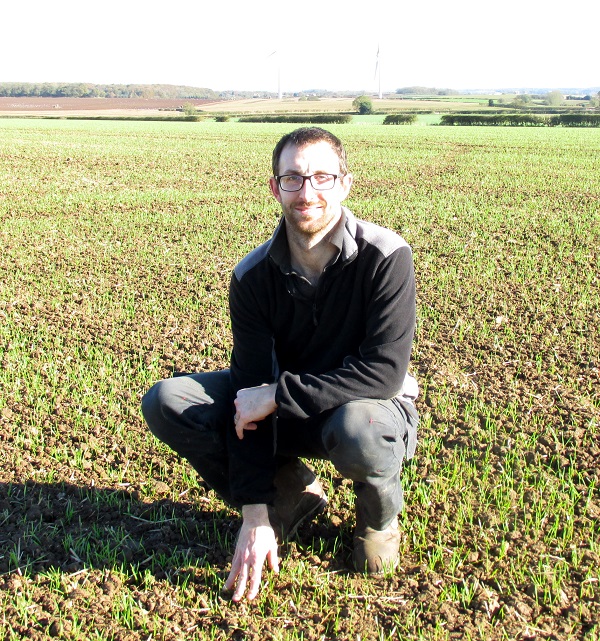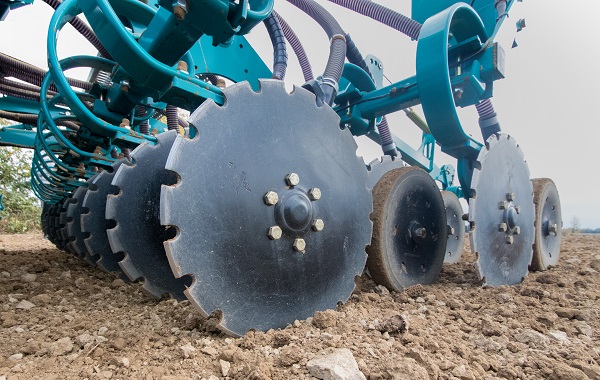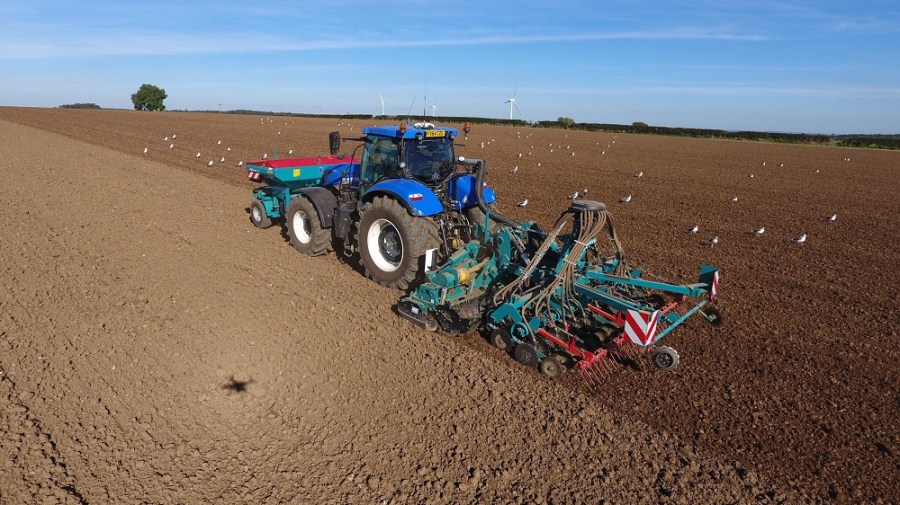Retiring farm staff pushed a South Yorks grower into rethinking his cultivation regime. But the resulting benefits amount to more than just time savings. CPM reports.
By David Jones
Until three years ago, South Yorks farmer Steven Skepper, his father, Alan, and the farm’s sole employee had been following the routine of ploughing all fields at Carr Farm, Harthill, after harvest, prior to cultivating and drilling. Three men, three tractors and a lot of diesel.
For some time before that, however, Steven had been looking for a way to reduce the commitment of man and tractor hours to the annual three-pass crop establishment process that had prevailed on the family’s farm for years. With the knowledge that his father and the employee were approaching retirement, he had become increasingly aware that something needed to be done.
“When they eventually do decide to retire, we won’t be able to afford to employ two full-time staff – and it would be nice if I was able take the odd day off every now and then!” he says.

Steven Skepper was seeking to reduce the manpower requirement at Carr Farm.
In the course of his research on the subject, Steven got to hear about a new combination set-up being produced by the French machinery manufacturer, Sulky. After seeing it for himself at the Cereals event, he talked to Platts Harris, the farm’s established dealer, and the process of acquisition was set in motion.
Carr Farm, a 365ha holding on mainly heavy land to the south east of Sheffield, follows a straightforward rotation of winter wheat, winter barley and winter beans on the bulk of the land, with around 40ha in stewardship schemes. Making use of surplus barn space, the business also includes 150 head of beef cattle, which are fattened indoors prior to slaughter.
“With neither my father nor our one employee getting any younger,” Steven explains, “I wanted to see if we could eliminate the middle pass, which would free up time for me to get involved in other tasks.
“I’d heard about the Sulky system with the front tank set-up and thought that it might provide a better balance to the combination. In the end, we went for the Xeos-TF front tank / Cultiline combination, with a folding, 4m Cultidisc drilling toolbar behind.” With these elements, it was the first combination of its type to be employed on a farm in the UK, replacing as it did the Skeppers’ Kverneland 4m tined seeder.

Steven Skepper was seeking to reduce the manpower requirement at Carr Farm.
It was also Steven’s first experience of using a combination drill and, since its acquisition, he’s managed to achieve considerably better seed beds than with previous tine drills, even in difficult, often lumpy, conditions.
He’s also been pleasantly surprised by the higher drilling speeds the set-up allows. “We were expecting to be able to cover around 16ha or so in a day,” he states, “but we found that we can actually get through more than 24ha. That’s a big difference – and very useful when weather windows are tight, which is often the case in this part of the world.”
Another bonus, Stephen found, has been the speed and ease of switching between crops, made possible by the universal metering system. Changing over from beans to a cereal, for example, takes just 10mins, Steven discovered. The rate of wear on the power harrow tines has also impressed, with a single set capable of drilling in the region of 500ha before needing to be changed.
When the Sulky combination was first delivered to Carr Farm, he recalls being impressed with the setting-up process. “Platts Harris – together with the Sulky customer service engineer, Richard German – spent a day and a half getting it completely fit for purpose,” Steven says, with their attention to detail extending “right down to the pipework for the front tank.”
The few initial teething blips were dealt with quickly, since which time the back-up and service from both Platts Harris and Sulky has been “first class,” he adds.
Steven, who also finds the time to fulfil his role as a New Holland Ambassador, says that as often as possible, machinery is supplied and maintained by the Platts Harris depot at Tuxford, a 40-min drive away. Platts also has a branch at Darley Dale, in Derbyshire, where his principal sales contact Paul Goodwin is based. This is a similar distance from Carr Farm, but, as Steven explains, tends to be more geared up for the needs of the hill-farming fraternity.
While most of the Skeppers’ regular contact with Platts Harris over time has been with Ian Akery, who works in the company’s service department, Paul has provided the main sales link for the past 12 years. His predecessor had maintained the relationship with the family for several decades prior to that.
“I feel that we, as a company, have built a very strong working relationship with the Skepper family,’ states Paul, “not just through machinery sales, but also through our after-sales team, who offer their services 24 hours a day, seven days a week during the harvest season.
“The Sulky machine became an option when the priority became to make drilling a two-man operation as opposed to the previous three – and to achieve a better seedbed,” he continues. “In 2014, a representative from Reco and myself took Steven to the Innov-Agri show in France to see a similar machine working on a Sulky demonstration plot.”
All three of them were very impressed by the Sulky Cultiline, which was purchased from Platts at the same time as a New Holland T7270 auto command tractor. The Sulky combination was supplied by Reco – at that time the UK importer – a company with which Platts Harris had also established a long-standing working relationship.
“The machine was built up and set off on farm by ourselves and a Reco representative ,” Paul recalls. “It was used to drill its first seedbeds in Oct, 2014.”
The Skeppers’ decisions on the choice of machinery are influenced to a large degree by the indigenous soil types and the terrain at Carr Farm. Field sizes vary between 2.5ha and 56ha and much of the land is undulating. Although mainly heavy, the soils vary between clay, sandstone and limestone types – often in the same field.
Yield mapping is also now employed which, again, has shown up marked variations within each field. “This is where the Sulky power harrow, properly set up, comes into its own,” notes Stephen.
Satellite machine guidance has come to play an important part in the way Carr Farm operates, with the RTK station positioned at the farm’s highest point. Mounted on the roof of one of the barns, it affords coverage of all the fields and delivers +/- 2.5cm accuracy. “It’s become an essential part of the arable process and we wouldn’t want to be without it now,” he states.
Asked, after three years of usage, if there’s any aspect of the combination that he’d change, Steven replies that he’s already done it. “What we did was to place a marker on the leading edge of the front hopper,” he explains. “This was done in order to assist the driver on the road at T-junctions, when moving between fields, by helping to avoid the front end of the combination from protruding onto main roads when halting.”
But this ‘oversight’ does little to dampen Steven’s enthusiasm for the Sulky: “It’s a good, well thought-out machine that’ll go in any conditions, assuming you’ve set it up correctly. When it first arrived here, it was in the middle of a wet Oct, but with a few tweaks it was good to go.”
However, the benefits of switching to this new set-up could be more far-reaching. Steven sees it as having the potential to play a key role in the on-going battle with blackgrass. “The main reason we were ploughing every year was as a means of stalling the spread, but it became apparent that it wasn’t working, as it continued to pose an ever-increasing threat to crop yields.
As the number of chemical options of dealing with it has dwindled, crop yields in some parts of Carr Farm have declined by 20-30%. “So, this year, we’ve tried min-tilling almost everywhere,” he reports. “They say that blackgrass seed can remain viable for six years when buried, so we’re going to leave it buried and wait and see if it comes up again.
“This autumn, we’ve drilled to between 2.5cm and 4cm – firmly, as we like it – so we can’t see the wheel marks from the drive tractor. Then the roller’s gone in.”
However, the Cultidisc component of the Sulky set-up is picked out for particular praise: “It’s certainly more aggressive than the standard, allowing the drill to work more efficiently in tougher conditions,” Steven reports. “The working pressure on the disc – up to 100kg – was another factor that made the Sulky more appealing, together with the ease of altering pressure and depth.”
The Sulky side of seed drills
Like many continental machinery manufacturers, Sulky is long-established and still family-owned. Founded in 1936, the company operates today from a €20m state-of-the-art factory at the French town of Chateaubourg, in Brittany, focussing on the manufacture of seed drills, fertiliser spreaders and cultivators. With a workforce of 250, Sulky builds more than 4000 machines a year, recently passing the 500,000 mark since beginning production.
The latest addition to the Sulky product range is the Duo hopper, which works in conjunction with the Xeos pneumatic seed drills. Doubling the number of hoppers enables a second product – such as slug pellets, fertiliser or another seed type – to be incorporated simultaneously. Clever.
Farm facts
Carr Farm, Harthill, S Yorks
- Farm size: 365ha
- Enterprise mix: winter wheat, winter barley, winter beans, with around 40ha in stewardship schemes; 150 head of beef cattle, fattened indoors
- Soil type: Mainly heavy clay, with some sandstone and limestone
- Mainline tractors: New Holland T7270 (265hp), T7210 (165hp) and T6090 (155hp); small JCB tractor for cattle duties
- Combine: New Holland CR 9080, with 7.6m header
- Drill: Sulky Xeos-TF front tank / Cultiline combination, with folding, 4m Cultidisc drilling toolbar
- Telehandlers: New Holland for the arable side and a compact JCB for the indoor cattle
- Sprayer: 28m Househam Spirit




